
|

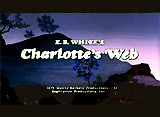
|
Charlotte's Web (1973) The animated musical drama from Hanna-Barbera Productions was based upon the popular 1952 children's book (of the same name) by E.B. White. The beloved tale (with mediocre-rated animation) was about the friendship between a talking, intelligent spider and her ill-fated pig friend Wilbur. She lived in a web above Wilbur's pig-pen. Spider Charlotte (voice of Debbie Reynolds) sacrificed herself for Wilbur (voice of Henry Gibson) to spare his life from being slaughtered (for bacon and pork), as she produced her own magnum opus (an egg sac with 514 children yet to be born). She was able, although it eventually exhausted and killed her, to spin words in her web (she had assured Wilbur: "You will live now, secure and safe") - the woven words were considered a miracle by the farm folk and they made Wilbur famous and judged as special and prophetic - and deemed him too important to be taken to market. She had told Wilbur about life's fate: "After all, what's life anyway? We're born, we live a little while, and we die...By helping you, perhaps I was trying to lift up my own life a trifle." Then, Charlotte shocked Wilbur by saying she wouldn't return home to the farm, and would soon die: "I'm done for, Wilbur. In a while, I'll be dead. I haven't even strength enough to climb down into the crate." Wilbur promised to save her egg sac and protect it until Charlotte's offspring were born. Then Charlotte sadly died on a wooden beam while singing part of the poignant and poetic "Mother Earth and Father Time."
Wilbur gave a despairing cry of "CHARLOTTE!" when he realized she was gone. In the conclusion, however, Charlotte's egg sac produced a new batch of spiders. Three of Charlotte's smallest (runt) offspring, too young to fly away, remained to continue being friends with Wilbur: Joy, Aranea, and Nellie. This narration concluded the film:
|
 Charlotte's Web-Weaving Miracles 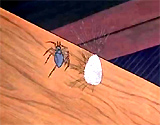 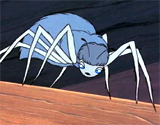 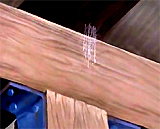 Charlotte's 'Death' |
||||||||||||||||||||||||||||||||||||||||||||||||

|
Director Nicolas Roeg's supernatural thriller opened with the scary drowning death of red-raincoated, young blonde daughter Christine (Sharon Williams) in a fishpond in England. Her red/white beach ball had fallen in the water and she tried to retrieve it. Her father John Baxter (Donald Sutherland), an architectural restoration expert, sensed her impending death and raced out of the country estate to the pond. The anguished, grief-stricken father dragged her lifeless body to the muddy bank and delivered CPR, but he was too late and couldn't save her. He spent most of the rest of the film haunted by her death. There were many visual foreshadowing clues given in the opening scene that were later elliptically inter-woven into the film, ominously portending further death:
When the grieving couple traveled to Italy shortly later, they befriended two elderly sisters, blind psychic Heather (Hilary Mason) and Wendy (Clelia Matania). It was stated by Heather that Christine could be seen among them, and John was warned that he was in grave danger. He conducted a long search for her in the city of Venice, where he faced his final moment of life after a number of false leads. He sighted an elusive small figure in a bright red hooded coat in a dark Venice alleyway - thinking it was his daughter being pursued by a serial killer, he pursued what turned out to be his nemesis. He ascended a swirling staircase, assuredly telling the figure with its back to him:
It wasn't his daughter - but a murderous dwarf (Adelina Poerio) - the one pictured sitting in the pew in the slide - who turned around, withdrew a long sharp knife from her right coat pocket, and deftly sliced his throat with one quick swing. He fell onto the stone floor and bled to death - punctuated by the peals of bells, swirling camera angles and quick images from earlier in the film. [Note: The slide was fully covered with a swirl of red - and destroyed.] John's funeral at a Venetian canal-side church ended the film.
|
 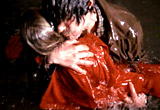 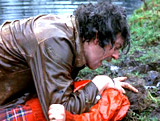 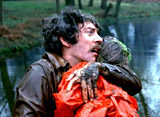 Drowning Death of Christine  Swirling Red "Bleeding" on Slide |
||||||||||||||||||||||||||||||||||||||||||||||||

|
The Exorcist
(1973) Director William Friedkin adapted William Peter Blatty's best-selling, 1971 blockbuster book about Satanic demon possession, and created one of the most disturbing, frightening, shocking, and exploitative films ever made. In a supremely self-sacrificial act during the cathartic finale of the horror film, the formerly-rebellious priest Father Damien Karras (Jason Miller) taunted the demon inside the possessed devil-girl Regan (Linda Blair) as he wrestled against her. He provoked and welcomed the demon to leave her body and come into his own so that he could destroy the Evil:
She grabbed and ripped the amulet medal from his neck - symbolically removing his protection from evil (foreshadowed previously in Damien's surreal dream). At the moment of his own demonic possession, he suddenly pulled back, his body trembled and his eyes rolled up (and turned green), and his face momentarily took on the appearance of Regan's demon. He growled and tumbled backwards. On the floor, Regan had regained her former self, and her stifled cries were made in her own voice, but she was terrorized by the demon within Karras. Now that he was filled with the beast-monster, he stood and staggered toward her with his arms outstretched to strangle her - but with all his own fortitude and strength, he screamed: "No!" as he battled the demon's attempt to kill her. He hurled himself toward the bedroom window - his body was thrown through the glass and he fell to his death on the steep concrete steps below. Karras [with a symbolic first name - Damien/Demon] gave his own life to save Regan's spirit and life, with the promise of being reborn. From the bedroom window, Lt. Kinderman (Lee J. Cobb) viewed Karras' bloodied body at the foot of the Prospect Street steps. Regan cried hysterically, but she was cured. With police cars and bystanders crowding around, Father Dyer (William O'Malley) broke through and grabbed Karras' hand, beseeching him:
Signaling his assent, Karras unclenched and gripped Dyer's hand. Dyer absolved him of his sins during the administration of last rites. The price or cost of Regan's recovery to sanity and wholeness was that both priests died during the exorcism. |
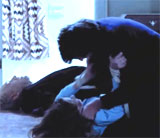 Father Karras Wrestling with the Demon Inside Regan  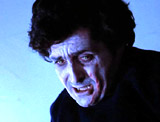 Demonic Possession Transferred 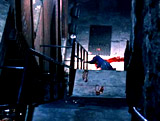 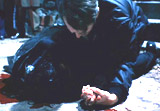 Karras Hurled to His Death |
||||||||||||||||||||||||||||||||||||||||||||||||

|
In the climax of this eighth Bond film, 007 agent James Bond (Roger Moore) was in mortal combat against criminal heroin drug dealer and statesman Dr. Kananga (Yaphet Kotto) within his subterranean lair on the Caribbean island of San Monique. Bond and "lover" Solitaire (Jane Seymour) were tied together, and Bond's forearm was sliced to draw blood and lure "diners" (sharks). The two were to be lowered into Kananga's pool and served up as bait for his pet sharks. 007 employed the magnet gadget on his Rolex watch to snag a CO2 shark bullet (he hid it in his mouth), and then used the buzz-saw gadget to cut himself free. In a final combative showdown, Bond and Kananga both fell into the shark pool, where Bond forced a large compressed-air shark bullet (or pellet) into Kananga's mouth and made him bite into it and swallow it. He pushed him below the water's surface, and then when the bullet discharged, his body began inflating, in a clearly-disgusting and gory death scene. He was propelled out of the water into the air like a rising helium balloon. When his floating-upward, engorged body struck an upper structure, his elasticized, swelled-up body of skin popped or exploded. When Solitaire was released and asked: "Where's Kananga?", Bond quipped:
|
 Bond vs. Kananga in Shark Pool 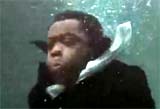 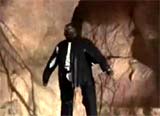 
Kananga's Body Swelling With Compressed Air Pellet - and Exploding |
||||||||||||||||||||||||||||||||||||||||||||||||

|
Sisters (1973) Director Brian DePalma's first real mainstream film was this low-budget psychological horror film, with homage to Hitchcock's Psycho (1960). It starred Margot Kidder as a beautiful and tormented 'Siamese twin.' It even featured a score by Bernard Herrmann (Hitchcock's own favorite composer). It was eventually revealed that the dual, once-conjoined main characters from Canada - Siamese twins - were one and the same:
Dominique had died on the operating table during the separation-operation, so there was no Dominique, even though a red herring scene of Danielle arguing with her sister in the bedroom (overheard by her first male victim) was inserted to be very misleading! After Dominique's death, Danielle experienced a severe schizoid personality disorder - and would easily become jealously murderous and deadly as "Dominique." After a one-night stand with Danielle in her fold-out living-room sofabed in her Staten Island apartment, "colored" TV game-show player and advertising salesman Philip Woode (Lisle Wilson) brought a birthday cake to her. He was led to believe that Danielle's sister had arrived to celebrate as well. [Note: The cake was inscribed with the names of both sisters.] As he walked the cake over to Danielle as she slept, and said "Surprise!", "Dominique" (with a huge carving knife to cut the cake) emerged from under the bedsheet. When she lunged at him, he was brutally and viciously stabbed (with multiple stab wounds, first in the mouth) - by the personality of once-conjoined, crazed and insane Siamese twin sister "Dominique." When he crawled across the floor to reach the discarded knife, "Dominique" attacked again - and stabbed him in the back.
The bloody and gruesome slaying was witnessed, with director Brian De Palma's split-screen technique, from an apartment window across the way by aspiring newspaper journalist Grace Collier (Jennifer Salt) (she was seated at her window, using her typewriter) as the dying victim scrawled with his blood to attempt to write the word HELP on a window. She immediately phoned for help ("I want to report an emergency, a murder!"). Later in the film, "Dominique" also slashed Danielle's strange, abusive ex-husband/doctor Emil Breton (William Finley) with a scalpel across his groin. He grabbed at his crotch, but could not stop the bleeding, and fell dead on top of her - after their bloody hands clasped together. Danielle embraced him, but it was too late. |
 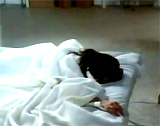 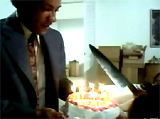 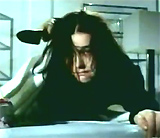 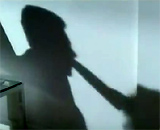 Many of the Stabbings Were Seen in Shadows 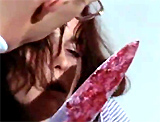 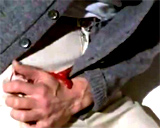 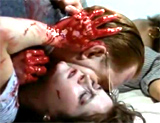 Death of Emil Breton |
||||||||||||||||||||||||||||||||||||||||||||||||

|
Woody Allen's science-fiction satirical comedy classic and screwball comedy was about the dystopic future 200 years ahead - a totalitarian government in the year 2173. The 'Leader' of the society was never seen except in pictures or on telescreens - portrayed as a wheel-chair bound dictator with a white dog. As part of a revolutionary movement against the Big-Brother authorities, there were two main subversive rebels:
The powers in charge had kept it a secret that the national leader was killed by a rebel bomb ten months earlier, and had been reduced to a benign, disembodied nose. Miles and Luna impersonated surgeons, who were promising to clone the Leader from the single remaining part of his body - his nose, but their real objective was to kidnap and kill the Leader. When found to be imposters, the two threatened to shoot the nose, and then when a chase ensued, Miles tossed the nose under a road-roller to assassinate the leader - flattening the nose beyond recognition.
|
 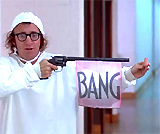 Threatening to Shoot the Nose |
||||||||||||||||||||||||||||||||||||||||||||||||
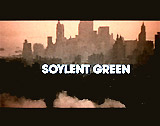
|
Soylent Green (1973) This early cautionary 70s science-fiction film by Richard Fleischer, set in an overpopulated, impoverished and polluted world of 2022, in particular in NYC, contained a well-known surprise plot twist ending. New York City Detective Thorn (Charlton Heston) had been assigned to investigate the murder of a wealthy businessman, William R. Simonson (Joseph Cotten), an influential board member of the financially-profitable Soylent Corporation that was manufacturing healthy, high-energy green wafers from ocean plankton. In the film's conclusion - the resigned Sol Roth (Edward G. Robinson in his final film role) walked to a government-sponsored Euthanasia Center or Clinic (a converted Madison Square Garden, known as "Home"), to seek God (who was "perhaps at Home") where he could request government-assisted suicide. Sol answered questions about his favorite color (orange) and favorite music (light classical) before being led in by another yellow-uniformed usher (Dick Van Patten) to one of the clinic's private chambers; he was placed on a comfortable bed in the orange-hued room amidst his choice of light classical music playing during the assisted-suicide procedure; he had been promised that it would last for 20 minutes. Thorn arrived at the "Home" and demanded to see and stop Sol's procedure, but he was too late; he was restricted and only allowed to watch from a viewing room adjacent to Sol's chamber - he was prohibited from speaking to Sol or being with him during much of the "ceremony"; Thorn refused to be blocked out and silenced, and threatened the usher to allow him to watch Sol's choice of a poignant, painless and suicidal death in the euthanasia clinic's chamber; from a control room through a window, Thorn was able to watch as Sol was presented with a visual montage of projected video (of a peaceful and "beautiful" green Earth ages ago when animal and plant life thrived and there was no pollution), accompanied by Tchaikovsky's "Pathetique" Symphony No. 6, Beethoven's "Pastoral" Symphony No. 6, and segments of Grieg's "Peer Gynt Suite."
When the two were finally permitted to speak to each other through the communications system, the dying Sol confessed: "Oh, dear God, I've lived too long"; Sol told Thorn: "I love you, Thorn," and Thorn replied: "I love you, Sol"; Sol asked: "Can you see it?...Isn't it beautiful?"; Thorn was completely astounded by the large-screen and its panoramic, serene and gorgeous images of flowers, wildlife, rushing fresh water, flocks of birds, deer, oceanic fish and other displays of nature - visuals of how the world once looked; Thorn began to shed tears when Sol bemoaned and revealed how flawed humans had destroyed the tremendous beauty and wonders of the Earth ("I told you"), and Thorn replied: "How could I know? How could I, how could I ever imagine?" And then after the wide-screen turned off and went black, Sol urged Thorn in his last dying words to expose the terrible truth of what he had learned about Soylent Green and its major secret - without describing any details; his discovery had prompted him to choose assisted suicide with a lethal drug: "Horrible. Simonson. Soylent. Listen to me, Thorn. Thorn, listen....You've got to prove it, Thorn. Go to the Exchange. Please, Thorn. Prove it, Thorn. The Exchange." Once Sol expired, bright lights were turned back on. In the film's conclusion, Thorn then proved the horrifying, predictable discovery of the true composition of the Soylent Corporation's new artificial food product Soylent Green - it was not composed of ocean plankton - ruled an impossibility by The Exchange (a group of oceanographic researchers) due to barren ocean conditions. Instead, it was composed of the recycled bodies of the deceased inhabitants of the society's euthanasia centers. |
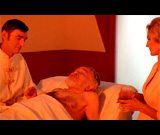 Sol Getting Comfortable Before a 20-Minute Assisted Suicide 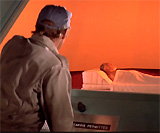  Thorn in an Adjacent Viewing Room To Witness Sol's Euthanasia 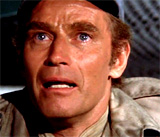 Thorn Shedding Tears Over the Gorgeous Beauty of a Past Earth, and Sol's Passing 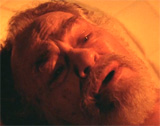 Sol's Last Dying Words to Thorn: "Please, Thorn. Prove it, Thorn. The Exchange" 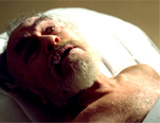 Sol's Actual Death - The Orange Light Was Extinguished |
||||||||||||||||||||||||||||||||||||||||||||||||
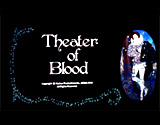
|
Theater of Blood (1973, UK) Douglas Hickox's campy black comedy-horror film from American International Pictures was originally titled Much Ado About Murder, and was obviously inspired by the success of star Vincent Price's Dr. Phibes movies. It reportedly required over six gallons of fake blood for the eight ghastly yet creative murders (see below), with a total body count of eleven. The demented, macabre film was mostly a series of elaborate and flamboyant Shakespearean death scenes. The film's tagline warned: "It's curtains for his critics." Egotistical and vain Shakespearean actor Edward Lionheart (Vincent Price in an over-the-top role) received poor reviews for his performances and stage adaptations from the theatrical Critics Circle. After he was passed over for the coveted Critic's Circle award for Best Actor, he apparently committed suicide - although his own death by drowning was faked (he was rescued from the Thames River). Then, the deranged, humiliated and murderous mad-man exacted deadly revenge on his nasty, London theater critics who had snubbed him and ended his career, with parodies of deaths from the last season of his Shakespearean plays. In many of the cases, Lionheart underwent numerous costume and hairstyle changes, while recreating the various roles for which he was criticized - as a doctor-surgeon, as a Scottish masseur, as a French chef, as a fencing instructor, as a camp hairdresser (with a huge afro wig), named "Butch," etc. Lionheart also gloriously gave a hammy recital of the words of Shakespeare as each of the critics met a dastardly demise. As Lionheart perished in the flames of the burning theatre, he was given a eulogizing, wry and cynical send-off by critic Devlin:
|
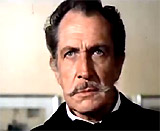  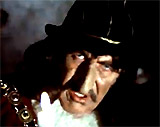 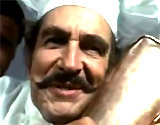 Edward Lionheart (Vincent Price) |
||||||||||||||||||||||||||||||||||||||||||||||||

|
The Wicker Man (1973, UK) In this suspenseful and erotic horror-occult film, sexually-repressed and devoutly religious Scottish policeman Sergeant Neil Howie (Edward Woodward) searched for a missing young schoolgirl named Rowan Morrison (Geraldine Cowper) from an anonymous tip in a letter. He believed that she was to be a potential virgin sacrifice (the May Queen) on May Day by openly-sexual pagan worshippers and inhabitants of the remote Scottish island of Summerisle, who worshipped the pagan teachings of leader Lord Summerisle (Christopher Lee). In the chilling finale of the cult classic, Howie learned that he was the one to be sacrificed. He was lured there to the island to be their good Christian sacrifice, to appease the gods and to bring a plentiful harvest. The 'missing' girl was never really missing. He was burned alive ("Oh, my God!") as the perfect virginal sacrifice inside the massive hollow 'wicker man' statue (created of wicker materials designed to be used for fire sacrifices) at sunset. He was told that he was the "unique" sacrificial one that they needed, for four reasons:
He protested his fate, but the heathen leaders refused to listen to him, believing that their apple crop would be restored because of his sacrifice. They prayed to the "Mighty god of the Sun, bountiful goddess of our orchards. Accept our sacrifice and make our blossoms fruit." As Howie was consumed by the flames, he recited the 23rd Psalm ("The lord's my shepherd, I'll not want, He takes me down to lie in pastures..."), and prayed for deliverance. |
 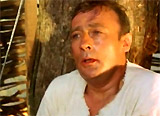  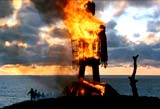 The Ritualistic Sacrifice of Sgt. Neil Howie in The Wicker Man |
||||||||||||||||||||||||||||||||||||||||||||||||
(chronological by film title) Intro | 1915-1929 | 1930-1933 | 1934-1938 | 1939 | 1940-1942 | 1943-1945 | 1946-1947 | 1948-1949 1950-1952 | 1953-1955 | 1956-1957 | 1958-1959 1960-1961 | 1962-1963 | 1964-1966 | 1967-1968 | 1969-1970 1971 | 1972 | 1973 | 1974 | 1975 | 1976 | 1977-1978 | 1979 1980 | 1981 | 1982 | 1983 | 1984 | 1985 | 1986 | 1987 | 1987 | 1988 | 1989 1990 | 1991 | 1992 | 1993 | 1994 | 1994 | 1995 | 1995 | 1996 | 1997 | 1998 | 1998 | 1999 2000-2001 | 2002 | 2003 | 2004 | 2005 | 2006 | 2007 | 2008 | 2009 | 2010 | 2011 |